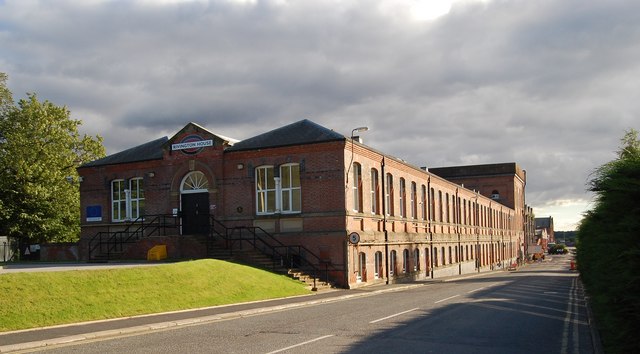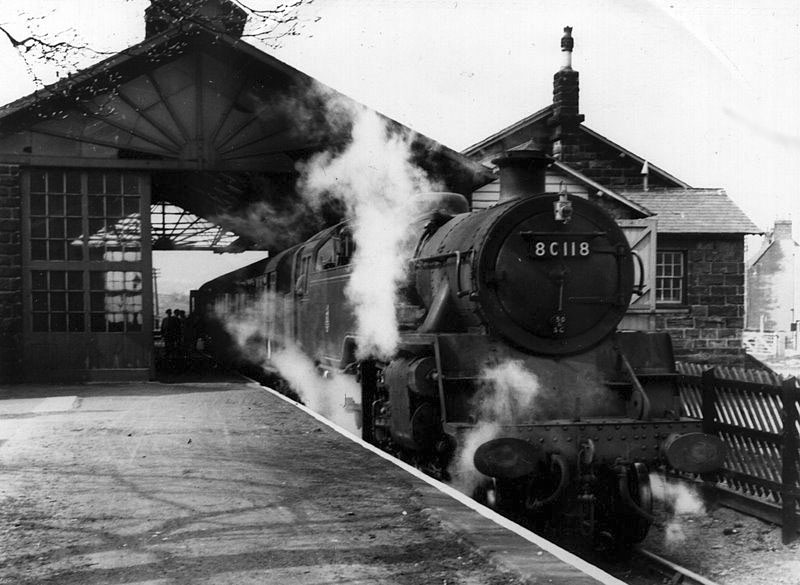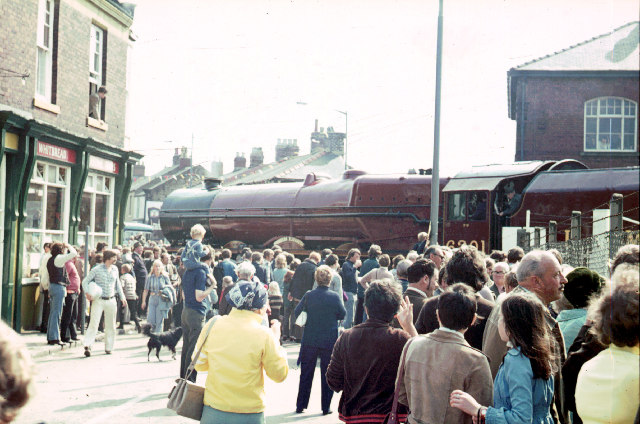|
LMS Ivatt Class 4
The LMS Ivatt Class 4 2-6-0 is a class of steam locomotive primarily designed for medium freight work but also widely used on secondary passenger services. The London, Midland and Scottish Railway (LMS) ordered 162 of this type between 1947 and 1952, but only three were built by the LMS before nationalisation in 1948. Designed by George Ivatt, they were classified 4F by the LMS and 4MT by British Railways (BR). In BR days they were used extensively across the system, being prevalent on the London Midland region and to a lesser extent elsewhere, notably on the Midland and Great Northern Joint Railway, an East Anglian line that had previously been joint owned by the LMS and LNER, where they became the dominant locomotive type. They were also used for a short period on the Somerset and Dorset Joint Railway, but were quickly transferred elsewhere, never to return, because of poor steaming on the line's long and steep gradients – this was before modifications were made to the desi ... [...More Info...] [...Related Items...] OR: [Wikipedia] [Google] [Baidu] |
Horwich Works
Horwich Works was a railway works built in 1886 by the Lancashire and Yorkshire Railway (LYR) in Horwich, near Bolton, in North West England when the company moved from its original works at Miles Platting, Manchester. Buildings Horwich Works was built on of land bought in April 1884 for £36,000. Rivington House, the first of several workshops was long by wide and opened in February 1887. The long brick built workshops had full-height arched windows and were separated by tram and rail tracks. Work to construct the three bay, long by wide, erecting shop began in March 1885. Inside were 20 overhead cranes. An gauge railway, with approximately of track was built to carry materials around the works complex, modelled on a similar system at Crewe Works. Two small 0-4-0 tank locomotives were bought from Beyer, Peacock and Company in 1887 to haul stores trains around the site, and six more were acquired at intervals to 1901. The first of these was bought from Beyer Peacock, bu ... [...More Info...] [...Related Items...] OR: [Wikipedia] [Google] [Baidu] |
Gordon The Big Engine
This article is about the characters that have appeared in the books of ''The Railway Series'' by the Rev. Wilbert Awdry and Christopher Awdry. Unless otherwise stated on this page, the technical notes come from actual notes laid out by Wilbert Awdry when he was developing the characters and setting for his stories; these notes are cited in his publication ''The Island of Sodor: Its People, History, and Railways''. North Western Railway These are the main rolling stock of the North Western Railway (NWR), commonly referred to as the Fat Controller's railway: Steam engines The Eight Famous Engines =Thomas (Number 1)= ''Thomas'' is a blue ex-London, Brighton and South Coast Railway E2 class locomotive. =Edward (Number 2)= ''Edward'' is an old blue ex-Furness Railway K2 class locomotive. He is the first character to appear in ''The Railway Series''. =Henry (Number 3)= ''Henry'' was originally a designed by Sir Nigel Gresley. He was built circa 1919 and arrived on Sod ... [...More Info...] [...Related Items...] OR: [Wikipedia] [Google] [Baidu] |
Bachmann Branchline
Bachmann Branchline is a British OO gauge model railway brand manufactured by Bachmann Europe PLC a subsidiary of Bachmann Industries, and is used for British outline OO scale model railways. Bachmann, a US company founded in 1835, was purchased by Kader Industries in 1987. Kader had previously produced models for Palitoy under the 'Mainline' brand. Palitoy required its manufacturers to produce and retain ownership of the toolings and Kader had used the toolings and added new ones for models commissioned by Replica Railways following the demise of Mainline. Kader formed Bachmann Europe PLC in 1989 with their main UK headquarters in Moat Way, Barwell, and the following year launched the Bachmann Branchline range for the British market with the moulds that had previously been used for Mainline Railways and Replica. From this starting point Bachmann has developed the range further and now produce a large range of models competing in particular with Hornby. In 2000, Bachmann Europ ... [...More Info...] [...Related Items...] OR: [Wikipedia] [Google] [Baidu] |
BR Standard Class 4 2-6-4T
The British Railways Standard Class 4 tank is a class of steam locomotive, one of the BR standard classes built during the 1950s. They were used primarily on commuter and outer suburban services. They were capable of reaching speeds of . Background On the nationalisation of British Railways (BR) in 1948, the London Midland Region had a number of ex- London, Midland and Scottish Railway 2-6-4T and the Western Region a number of GWR Large Prairie 2-6-2T types. These tank engines were particularly suited to commuter and secondary services. However, particularly in Scotland and the Southern Region, the situation was not so good, with large numbers of pre-grouping types struggling on. Design and construction On the decision to build the BR standard series of locomotives, a series of class four tank engines was ordered, based on the ex- LMS Fairburn 2-6-4T with some modifications. The lineage of the class could therefore be tracked through the LMS/BR Class 4 2-6-4T locomot ... [...More Info...] [...Related Items...] OR: [Wikipedia] [Google] [Baidu] |
GWR 7800 Class 7812 Erlestoke Manor
7812 ''Erlestoke Manor'' is a preserved GWR 7800 Class steam locomotive, operated by the Great Western Railway and later British Railways. Owned by the Erlestoke Manor Fund, as at December 2022 it was in operational condition on the Severn Valley Railway. GWR/BR operations Built at Swindon Works in January 1939, it was first allocated to Bristol Bath Road depot. It was reallocated to in August 1950, and Plymouth Laira in March 1959. Transferred to Oswestry in May 1960, its final allocation was to in February 1963. Withdrawn from British Railways service in November 1965, it was sent to Woodham Brothers scrapyard in Barry, South Wales. Preservation The locomotive was purchased by the Erlestoke Manor Fund in June 1973. It was moved from Barry to a temporary home at the Dowty Railway Preservation Society, Ashchurch in May 1974, pending an eventual move to the Dean Forest Railway. However in 1976 Fund members approved a move to the Severn Valley Railway instead, where restora ... [...More Info...] [...Related Items...] OR: [Wikipedia] [Google] [Baidu] |
LMS Stanier Class 5 4-6-0 5000
LMS Stanier Class 5 4-6-0 number 5000 is a preserved British steam locomotive. It is part of the National Railway Collection. Service 5000 was built at Crewe in 1935 and was initially the first numerically of its class. It however was not the first to be built because the Vulcan Foundry had turned out the first of their simultaneous order, No. 5020 in 1934. It also ceased to be the first numerically when No. 4800 was built in 1944, after the LMS ran out of available numbers after No. 5499 was built. 5000 was built with a low degree superheat domeless boiler. 5000 had 40000 added to its number to become 45000 after nationalisation in 1948 by British Railways. Preservation After withdrawal from Lostock Hall shed, near Preston in 1967, 5000 was selected to represent its 842-strong class as part of the National Railway Collection. Part of the reason for this was that it had a domeless boiler and was roughly in the condition as built. It was therefore painted in its original ... [...More Info...] [...Related Items...] OR: [Wikipedia] [Google] [Baidu] |
Rainhill
Rainhill is a village and civil parish within the Metropolitan Borough of St Helens, in Merseyside, England. The population of the civil parish taken at the 2011 census was 10,853. Historically part of Lancashire, Rainhill was formerly a township within the ecclesiastical parish of Prescot, and hundred of West Derby. Following the Local Government Act 1894, it became part of the Whiston Rural District. The Rainhill Trials of 1829 resulted in the selection of Stephenson's ''Rocket'' as the world's first modern steam locomotive. History Early history Rainhill has been recorded since Norman times but its name is believed to come from the Old English personal name of Regna or Regan. It is thought that around the time of the Domesday Book that Rainhill was a part of one of the townships within the "Widnes fee". Recordings have shown that in the year of 1246, Roger of Rainhill died and the township was divided into two-halves for each of his daughters. One half was centred on the ... [...More Info...] [...Related Items...] OR: [Wikipedia] [Google] [Baidu] |
Shildon
Shildon is a town and civil parish in County Durham (district), County Durham, in England. The population taken at the 2011 Census was 9,976. The town has the Locomotion Museum, due to it having the first , built in 1825, and locomotive works on the Stockton and Darlington Railway. History The name Shildon comes from the Old English word ''sceld'', This translates as 'shelf shaped hill' or 'shield/refuge'. Another possibility is the Old English word ''syclfe'' meaning 'shelf' and the suffix ''duri'' meaning 'hill'. This refers to the town's location on a limestone escarpment.Shildon County Durham Conservation Area Prepared for Sedgefield Borough Council Conservation Area Character Appraisal December 2008 ''Report No: 0055/1-08'' Report by Archaeo-Environment Ltd The earliest inhabitants of the area were most likely present from the Mesolithic period some 6,000 years ago. Although no evidence of settlement has been found in Shildon itself a small Stone tool, flint tool dis ... [...More Info...] [...Related Items...] OR: [Wikipedia] [Google] [Baidu] |
Severn Valley Railway
The Severn Valley Railway is a heritage railway in Shropshire and Worcestershire, England. The heritage line runs along the Severn Valley from Bridgnorth to Kidderminster, following the course of the River Severn for much of its route, and crossing the river on the historic Victoria Bridge. The railway is the sixth-longest standard gauge heritage line in the United Kingdom. Train services are hauled predominantly by steam locomotives, with vintage diesel locomotives hauling occasionally. Diesel locomotives are also used for engineering trains, to replace failed steam locomotives at short notice, and during periods of high fire risk. The railway hosts numerous special events throughout the year, including both steam and diesel galas. History Commercial history The Severn Valley Railway was built between 1858 and 1862, and linked Hartlebury, near Droitwich Spa, with Shrewsbury, a distance of . Important stations on the line were , , and within Worcestershire; and , , , , , ... [...More Info...] [...Related Items...] OR: [Wikipedia] [Google] [Baidu] |
Lostock Hall
Lostock Hall is a suburban village within the South Ribble borough of Lancashire, England. It is located on the south side of the River Ribble, some south of Preston and north of Leyland. It is bordered on its southeastern side by the interchange for the M6, M61 and M65 motorways. At the time of the United Kingdom Census 2001, the central Lostock Hall area had a population of 3,948,Neighbourhood Statistics - Lostock Hall (Ward) URL accessed 17 November 2007. falling to 3,762 at the 2011 Census. Lostock Hall traces its origins to James de Lostock who in 1212 built Lostock's Hall in the then rural area of Cuerden Green in the |
In Situ
''In situ'' (; often not italicized in English) is a Latin phrase that translates literally to "on site" or "in position." It can mean "locally", "on site", "on the premises", or "in place" to describe where an event takes place and is used in many different contexts. For example, in fields such as physics, geology, chemistry, or biology, ''in situ'' may describe the way a measurement is taken, that is, in the same place the phenomenon is occurring without isolating it from other systems or altering the original conditions of the test. The opposite of ''in situ'' is ''ex situ''. Aerospace In the aerospace industry, equipment on-board aircraft must be tested ''in situ'', or in place, to confirm everything functions properly as a system. Individually, each piece may work but interference from nearby equipment may create unanticipated problems. Special test equipment is available for this ''in situ'' testing. It can also refer to repairs made to the aircraft structure or flight con ... [...More Info...] [...Related Items...] OR: [Wikipedia] [Google] [Baidu] |
West Riding Of Yorkshire
The West Riding of Yorkshire is one of three historic subdivisions of Yorkshire, England. From 1889 to 1974 the administrative county County of York, West Riding (the area under the control of West Riding County Council), abbreviated County of York (WR), was based closely on the historic boundaries. The lieutenancy at that time included the City of York and as such was named West Riding of the County of York and the County of the City of York. Its boundaries roughly correspond to the present ceremonial counties of West Yorkshire, South Yorkshire and the Craven, Harrogate and Selby districts of North Yorkshire, along with smaller parts in Lancashire (for example, the parishes of Barnoldswick, Bracewell, Brogden and Salterforth became part of the Pendle district of Lancashire and the parishes of Great Mitton, Newsholme and Bowland Forest Low became part of the Ribble Valley district also in Lancashire), Cumbria, Greater Manchester and, since 1996, the unitary East Riding of ... [...More Info...] [...Related Items...] OR: [Wikipedia] [Google] [Baidu] |






